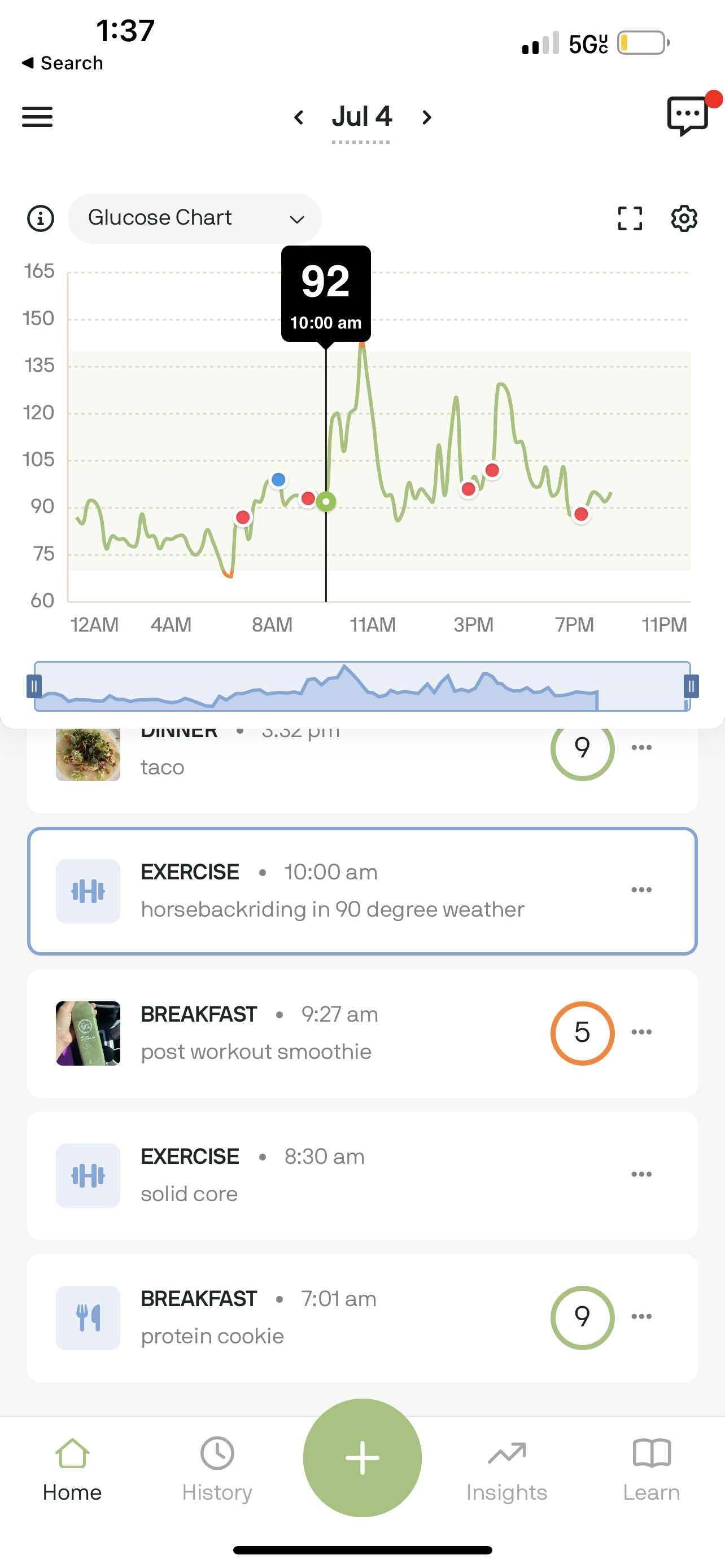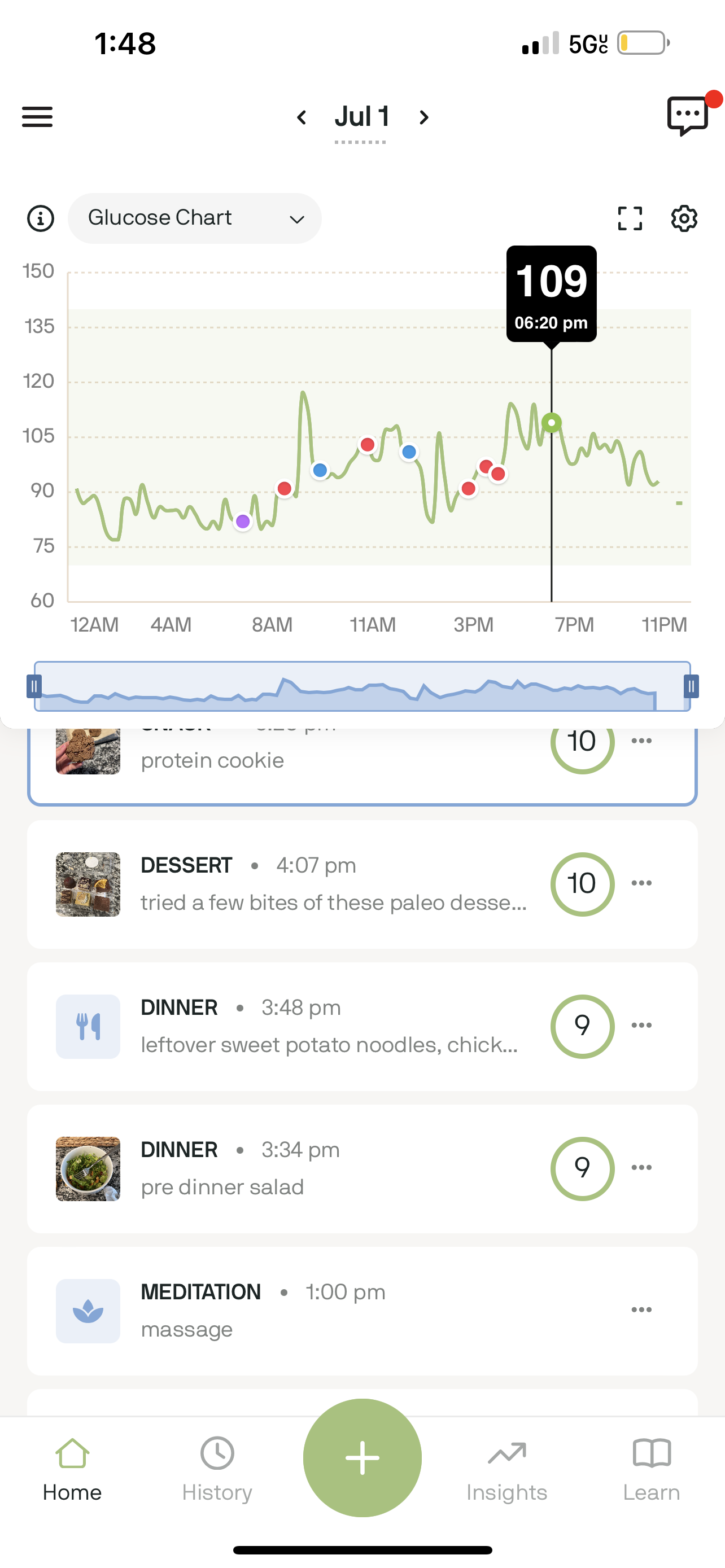I wore a CGM for two weeks: Here’s what I realized.
Disclaimer: This post is an un-paid partnership with Nutrisense. They supplied me with a CGM, so that I could let you all know my thoughts on it!
Want to try wearing a CGM? Use code ALITTLEMOREBALANCED25 to save $25 on your order with Nutrisense!
Imagine you just ate a big bowl of pasta and finished it off with a slice of vanilla cake, sounds good, right? But wait, thirty minutes after the meal hits, and you start to feel a little sleepy- but it’s fine; you probably just didn’t sleep well the night before, right? No, wait, you remember you got 8 hours and woke up full of energy, so what is happening?! Another 30 minutes pass, and now you need to lay down and take a nap; you sleep for thirty minutes and wake up feeling flushed and groggy; your face might even feel warm and red. But then you start to feel hungry, and you’re confused because of the giant meal you just consumed an hour ago. But then you remember what’s actually happening- you had a giant blood sugar spike.
Does this sound like something you experience? If so, keep reading. We’re going to dive into why this happens and what we can do to solve it.
See that little dot on my right arm there? Thats a CGM or Continous Glucose Monitor, and the point of it is to provide real-time insights into my blood glucose levels, empowering me to make informed decisions about my diet, exercise, and overall lifestyle to effectively manage my blood sugar and optimize my health. Historically, they have been worn by individuals with diabetes to manage their blood sugar- but recently more non-diabetics like myself have started wearing them to take control of their bodies.
I have always been the person that was very sensitive to food. My parents have pictures that they laugh at from high school of my “post dinner naps” on the couch after indulging in a heavy carb-based meal like I used to before I was diagnosed with celiac disease. I brought this up to a doctor one day before I became a functional practitioner, and he told me that it sounded like I had insulin resistance; or a condition where cells in the body become less responsive to the effects of insulin, leading to impaired glucose uptake and elevated blood sugar levels, often associated with metabolic disorders such as type 2 diabetes. Now I didnt have diabetes or even was remotely pre-diabetic, so I was confused but shook it off. Little did I know when I went back to school years later, that he would be right.
I’ve worn CGM’s in the past and found out a lot about my body. But I realized that when I was wearing them, I was more concerned with keeping my levels stable during the day than testing certain foods, so I decided this time would be different. I was going to eat what I would normally eat and see how it went.
I won’t bore you with the whole story, but I will share some of my main takeaways and show you pictures of the graphs during the days I wore it.
First, lets talk fruit.
I live in South Florida, so we have alot of juice bars down here. After my workout class, I usually stop by one on the weekend and grab a quick smoothie. I do know that bananas, apples and oranges tend to spike me a little bit more than other fruits but I wanted to test it again. This smoothie had ALOT of fiber, but the main ingredient was a banana. And as we can see, my blood sugar was NOT happy with this option. I was even active after I drank it, which can sometimes help.
If I were going to do this again, here’s what I would change:
I would eat protein before my smoothie, maybe a chicken sausage or higher fat type of meat.
Eating something like this before drinking something higher in sugar (even if its natural sugar) can help reduce the glucose spike. Normally, I would say to add in more activity but I was already pretty active after this smoothie.
Next, let’s talk Carbs.
I am a HUGE fan of carbs. Not only are they delicious, but they also give us energy and lets be real- keep us happy. I will never be one to sit here promoting a keto diet, instead lets talk about ways to reduce the spike while still enjoying carbs.
You can see above I had a bowl of chicken, sweet potato noodles, sweet potatoes, brocolli and kale. Sounds great right? I thought so too until I saw my score. It REALLY spiked me and I felt super tired and irritated after eating it, but its a meal that I enjoy so I wasnt going to let it stop me from continuign to enjoy it. Let’s look at what I did differently next time.
Waalahhh!! Like magic, I added a pre-dinner salad the next day that was full of veggies and fiber. Adding this in before a higher-carb meal allowed my body to slow down digestion, and reduce the rate at which carbohydrates are absorbed, resulting in a slower and more controlled release of glucose into the bloodstream.
My Biggest Takeaways:
Eat a high-fiber meal before your actual meal. This could be a salad, a handful of veggies, etc.
Berries > everything. Berries caused a very minimal spike on my CGM and are so good!
Don’t underestimate walking. A quick 10-minute walk after meals can help control blood sugar levels and reduce spikes, you’ll feel great after too!
Give your digestion a break: my body responded better to four larger meals than snacking throughout the day. You may be different so it’s always important to test!
Data is everything! Being able to see what foods are impacting your blood sugar is such a gift. Highly recommend grabbing a CGM and seeing it for yourself!
Want to try wearing a CGM? Use code ALITTLEMOREBALANCED25 to save $25 on your order with Nutrisense!





